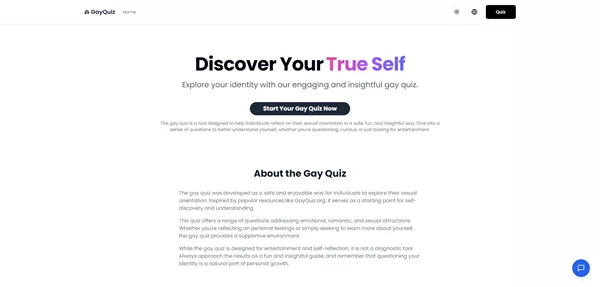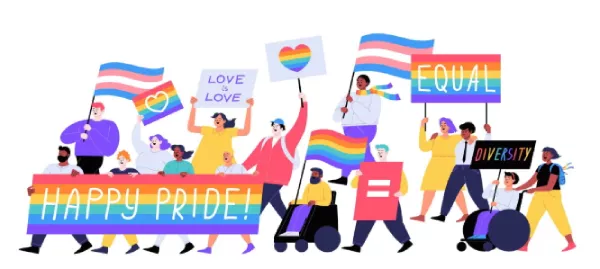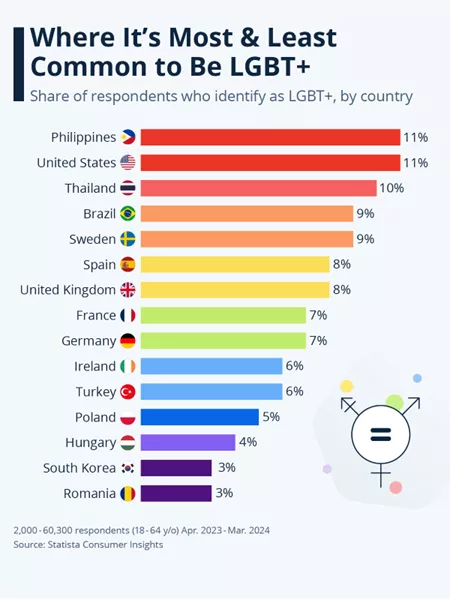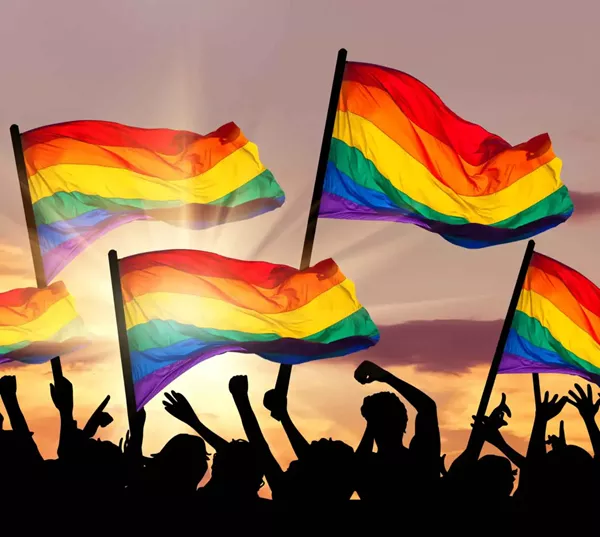Am I Gay? A Quiz to Explore Your Sexuality
Questioning your sexuality can be a confusing and sometimes overwhelming experience. You're not alone. Many people grapple with understanding their attractions and feelings. An online sexuality test can offer a safe and supportive space to begin this journey of self-discovery. It's not a definitive answer, but rather a tool designed to spark introspection and help you explore your inner landscape. Unsure where to start? Take our free assessment today!

What is the "Am I Gay" Quiz and How Can It Help?
The "Am I Gay" quiz is a carefully crafted set of questions designed to help you reflect on your sexual orientation. It's important to understand that this is not a diagnostic tool or a crystal ball. It won't definitively label you. Instead, it acts as a starting point, prompting you to consider thoughts and feelings that you might not have fully acknowledged.
The quiz explores your feelings toward various situations, attractions, and preferences. By honestly answering the questions, you can gain valuable insights into your potential attractions and inclinations. Remember, it's about understanding yourself better, not fitting into a predetermined box. So, if you are questioning and want to find out answers, consider taking a free online test [https://gayquiz.org] to explore your feelings.
7 Signs You Might Be Gay (Beyond a Quiz)
While a "how gay am I quiz" or similar tools can't definitively define you, there are some common signs and feelings that might suggest you're gay or exploring same-sex attraction. Consider these points as additional avenues for self-reflection:

-
Attraction to the Same Sex: This is perhaps the most obvious sign. Do you feel romantically or physically drawn to people of the same sex? This could manifest as a crush, infatuation, or a desire for a deeper, more intimate connection.
-
Fantasies & Daydreams: Pay attention to your inner world. Do your daydreams or fantasies frequently involve people of the same sex? These mental scenarios can provide valuable clues about your underlying desires and attractions.
-
Curiosity about LGBTQ+ Experiences: Do you find yourself drawn to learn more about LGBTQ+ identities, communities, and stories? This curiosity can reflect a subconscious desire to understand your own feelings and potentially find a sense of belonging.
-
Disinterest in Opposite-Sex Relationships: Do you find it challenging to connect romantically or physically with people of the opposite sex? This disinterest could indicate that your attractions lie elsewhere. It's important to note that this doesn't automatically mean you're gay, but it's worth exploring further.
-
Feeling Different Growing Up: Many LGBTQ+ individuals report feeling "different" during childhood, even if they couldn't articulate why at the time. This feeling of being an outsider or not quite fitting in can be a common experience.
-
Emotional Resonance with LGBTQ+ Media: Do you feel a strong connection to LGBTQ+ movies, books, or characters? This emotional resonance can point to deeper questions about your own identity and experiences.
-
Craving Same-Sex Affection: Does the idea of being in a relationship with someone of the same sex feel exciting, comforting, or natural? These feelings are worth exploring and acknowledging.
LGBT Demographics and Statistics: Understanding the Community
Understanding the demographics and statistics of the LGBTQ+ community can provide valuable context and a sense of belonging. Here's a look at some relevant data from around the world:

LGBT in Australia
-
Population Estimates: According to the Australian Bureau of Statistics (ABS), approximately 920,000 Australians identify as gay, bisexual, sexually diverse, or gender diverse. This includes roughly 740,000 people (3.6%) identifying as sexually diverse and approximately 178,900 people (nearly 1%) identifying as gender diverse.
-
Age Distribution: Higher rates of LGBTQ+ identification are observed among younger individuals, with 9.5% of those aged 16 to 24 identifying as LGBTI+ and 1.8% as gender diverse.
LGBT in the United States
-
LGBT Identification: A March 2024 Gallup poll indicated that 7.6% of U.S. adults identify as LGBT. The distribution within this group is as follows: 57.3% identify as bisexual, 18.1% as gay, 15.1% as lesbian, 11.8% as transgender, and 4.2% as another LGBT identity (e.g., pansexual).
-
Generational Differences: LGBT identification is more prevalent among younger generations, with 22.3% of Generation Z and 9.8% of Millennials identifying as such, compared to 4.5% of Generation X and 2.3% of Baby Boomers.
LGBT in New Zealand
-
Census Data: The 2023 New Zealand census reported that 4.5% of adults (172,383 people) identify as LGBTIQ. In terms of sexual identity, 54% identify as bisexual, 30% as gay or lesbian, and 13% as another sexual identity. Additionally, 0.7% of the adult population (about 23,000 people) identify as transgender.
-
Regional Variations: Wellington has the highest proportion of individuals belonging to LGBTIQ communities at 11.3%, followed by Dunedin (7.3%) and Christchurch (6%).
Global Perspective on LGBT Identification
- A 2021 Ipsos survey across 27 countries found that, on average, about 80% of people identify as heterosexual, 3% as gay, lesbian, or homosexual, 4% as bisexual, 1% as pansexual or omnisexual, and 1% as asexual. Notably, younger generations, particularly Generation Z, are more likely to identify as bisexual (9%) compared to older generations.
Why Online "Am I Gay" Quizzes Aren't Always Accurate
It's crucial to approach online quizzes like a sexuality test [https://gayquiz.org] with realistic expectations. While they can be a helpful starting point for self-reflection, they are not infallible. Here's why:

Sexuality is complex and personal.
Sexuality is a multifaceted aspect of identity, influenced by emotions, relationships, experiences, and personal history. A quiz, by its very nature, cannot capture the nuances of individual experiences.
Reinforcing stereotypes and providing misleading results.
Some quizzes might rely on outdated stereotypes or present questions in a way that leads to inaccurate conclusions. It's essential to be aware of this potential bias and interpret the results with caution.
Self-reflection and seeking professional guidance
The most reliable way to understand your own sexuality is through meaningful self-reflection and, if needed, guidance from a qualified counselor or therapist. These resources can provide a more personalized and nuanced understanding of your feelings and attractions.
Understanding Key Terms: LGBT, LGBTQ+, LGBTQIA+, and More
The acronyms LGBT, LGBTQ+, LGBTQIA+, and even longer variations represent the diverse spectrum of sexual orientations, gender identities, and expressions within the community. Here's a breakdown of the key terms and their meanings:

L - Lesbian
A lesbian is a woman who is romantically, emotionally, or sexually attracted to other women.
G - Gay
"Gay" typically refers to a person who is romantically, emotionally, or sexually attracted to individuals of the same gender. While often associated with men, the term can apply to people of all genders. You can explore your feelings by taking a gay quiz [https://gayquiz.org].
B - Bisexual (Bi)
Bisexual individuals experience romantic, emotional, or sexual attraction to more than one gender, often to both men and women.
T - Transgender
Transgender describes people whose gender identity or expression differs from the sex they were assigned at birth.
Q - Queer
Queer is an inclusive term that encompasses a range of sexual orientations and gender identities outside of cisgender and heterosexual norms. Historically used as a slur, it has been reclaimed by many in the LGBTQ+ community as a term of empowerment, though its use is still sensitive.
Q - Questioning
This term refers to individuals who are exploring or unsure about their sexual orientation or gender identity.
I - Intersex
Intersex refers to people born with physical or genetic traits that don't fit typical definitions of male or female bodies. This might include variations in chromosomes, hormones, or reproductive anatomy.
A - Asexual
Asexuality describes individuals who experience little to no sexual attraction toward others. However, asexual people may still engage in romantic relationships, fantasies, or sexual activity. Asexuality exists on a spectrum and can vary from person to person.
A - Ally
Allies are individuals who support and advocate for the LGBTQ+ community, even if they do not identify as part of it.
P - Pansexual
Pansexual individuals are attracted to people regardless of their sex or gender identity, focusing instead on the person as a whole.
GQ - Gender Queer
Gender queer is a term for those whose gender identity does not align strictly with male or female categories, often existing outside the traditional gender binary.
GV - Gender Variant
Gender variance refers to behaviors or expressions that don't conform to traditional gender norms. This may include individuals who reject conventional ideas of masculinity or femininity.
How to Approach the "Am I Gay" Quiz Mindfully
If you decide to take a gay test [https://gayquiz.org], keep these tips in mind to make the experience more meaningful and less anxiety-inducing:
Answer honestly and privately.
The quiz is for you and you alone. No one else will see your results. Therefore, honesty is key to gaining valuable insights. Find a private space where you feel comfortable and free from distractions.
Results are not definitive.
Remember that the results of the quiz are not a final judgment on your sexuality. They are simply a tool for exploration and self-reflection. Don't feel pressured to conform to a particular label based on the outcome.
Focus on reflection, not perfection.
The quiz is not a test that you can pass or fail. It's an opportunity to reflect on your feelings and attractions. Approach it with curiosity and openness, rather than striving for a "perfect" score.
Self-Acceptance: The Real Goal of Sexuality Exploration
Ultimately, the purpose of exploring your sexuality, whether through quizzes, conversations, or personal reflection, is to cultivate self-acceptance.

Labels are helpful, but not the goal.
Labels can provide a sense of community and belonging, but they are not the ultimate destination. The goal is to be at peace with who you are, regardless of whether you fit neatly into a particular category.
Self-discovery is rarely linear.
The journey of self-discovery is often winding and unpredictable. One quiz or conversation isn't going to answer every question. Be patient with yourself and allow the process to unfold naturally.
Don't rush, explore your feelings.
There's no need to rush or have everything figured out immediately. Give yourself permission to explore your feelings at your own pace.
Conclusion: Curiosity and Empowerment
Questioning your sexuality is a sign of growth and self-awareness. You're giving yourself permission to ask big questions about your identity and desires. If you're ready to take the next step, take our quiz today [https://gayquiz.org] and start your journey of self-discovery. Remember that curiosity is a powerful tool for personal growth.
FAQ: Common Questions About Sexuality and Identity
Here are some frequently asked questions about sexuality and identity:
-
Am I queer or just curious? Curiosity is a normal part of human sexuality. Exploring your feelings and attractions doesn't automatically make you queer. It simply means you're open to understanding yourself better.
-
Am I bisexual? Bisexuality involves attraction to more than one gender. If you feel drawn to both men and women (or other genders), you might be bisexual. Try a sexuality quiz [https://gayquiz.org] to help discover answers.
-
How do you tell if you like girls? If you're a woman (or identify as female), you might like girls if you experience romantic, emotional, or sexual attraction to other women.
-
How do you know if you identify as queer? You might identify as queer if you feel that your sexual orientation or gender identity falls outside of traditional norms and you embrace that identity.
-
How do you know if you're LGBT? You are LGBT if you identify as lesbian, gay, bisexual, or transgender. The LGBTQ+ acronym encompasses a broader range of identities.
-
Can I say queer if I'm straight? Generally, it's not appropriate for straight people to use the term "queer" to describe themselves, as it's a term that has historically been used to marginalize LGBTQ+ individuals. However, straight individuals can be allies to the queer community.
-
How do I know if I'm straight? If you are exclusively attracted to the opposite sex, you likely identify as straight.
-
What are queer people attracted to? Queer people are attracted to a wide range of genders and identities, depending on their individual sexual orientations.
Ready to start exploring your feelings and attractions? Find out more today! [https://gayquiz.org] Remember, this quiz is not a definitive answer, but rather a tool for self-reflection.